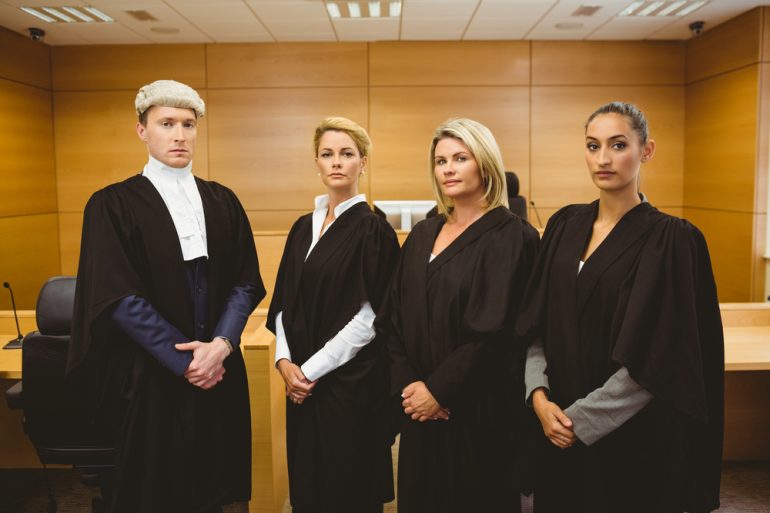What do the traditions of the Malaysian Bar stand for?
The Malaysian Bar has preserved the traditions of the legal profession. Some of them are more than 500 years old. The Bar insists on keeping them. Why?
The oldest records of the Inns of Court are said to be the Black Books of Lincoln’s Inn. They place the beginnings of the English Bar to the year 1422.
Some historians trace the origins of the English Bar to a date far before that.
As the British Empire expanded, British barristers arrived to set up practice first in India; and afterwards, across the Commonwealth. By this migration, the Malayan Bar inherited many of the English Bar’s traditions.
We have one or two homegrown ones as well.
‘Tradition’ signifies the transmission of long-established customs.
[1]. Why does one refer to judges as the ‘Bench’ and the advocates as the ‘Bar’?
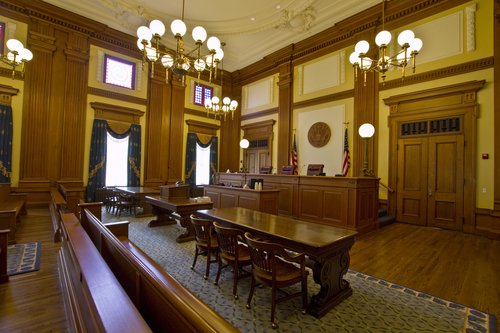
In the days of old, a courtroom was enclosed by two parallel, raised, horizontal bars. These bars divided a court into three areas. One bar separated a raised platform, used by the judges’ as a table, from the rest of the room. This was known as the ‘Bench’.
The second bar separated the area for lawyers from the space allocated to members of the public. From this area, onlookers could observe court proceedings. And so it came to be called the ‘Gallery’.
The two ‘bars’ enclosed the lowered central area, often called the ‘Well of the court.’ That is a space reserved only for legal practitioners to sit. In reality barristers were ‘advocates’. They ‘advocated’ for the rights of their clients. To this day, unless the court invites a person into the Well, no one has a right to sit there except the advocates.
Over time, judges came to be referred to as ‘the Bench.’ The barristers were collectively known as ‘the Bar’.
Under the Legal Profession Act 1976, the collective body of advocates and solicitors in Peninsular Malaysia is known as the ‘The Malaysian Bar’. Hence a legal practitioner will introduce himself to you with these words: ‘I am a member of the Bar.’
[2]. Wigs, gowns, bands and Bar jackets
Over time, the design of a legal practitioner’s sartorial ensemble assumed a particular form. So, no discussion of the traditions of the Bar can be complete without an explanation of the usage of wigs, gowns, bands, and the use of certain expressions or certain codes of conduct in the courts of law.
[3]. Robe [or gown]
Barristers have worn robes since mediaeval times. It was a sign of scholarship. Until the Tudor period, the robes were closed at the front and brightly coloured. By the start of the 16th century, robes were long open gowns of sombre colour, typically mulberry.
The gown [or ‘robe’ as it known in Malaysia] was only worn in court. It had pleated shoulders and bell-shaped sleeves. The sleeves tapered at the elbow with two buttons. These type of robes were once only worn by juniors. Senior barristers, called ‘Queen’s Counsel,’ wore silk gowns and elaborate buttoned jackets.
In Malaysia, we have done away with this difference.
[4]. Why black?
It is said that the British tradition of wearing black robes began when barristers and judges adopted – in 1694 – the mourning dress for Queen Mary II.
Then, high court judges reverted to robes of scarlet and violet. But barristers retained their black gowns; as did subordinate court judges. By the eighteenth century, American judges had followed suit.
The second theory is more plausible. It grounds its hypothesis on the fact that black dye was expensive in ancient times. It was therefore unavailable to commoners. The use of black tunic were the preserve of the well-heeled. Over 400 years ago, the Bar composed of persons who had means to tertiary education. These were usually members of the aristocracy. It stood to reason that they had the money, and therefore the privilege, to wear black gowns.
By late 17th century, barristers had adopted black gowns.
[5]. The liripipe
The robe has a piece triangular chute or pouch attached to the left shoulder. This was the cast over the barristers’ shoulder. From the bag, a hollow cloth tassel [known as ‘liripipe,’] projected over, and into, the front of the left shoulder. It is cut in two lengthways. It was a cloth pipe.
The reason for its existence is mysterious. There are two theories about it.
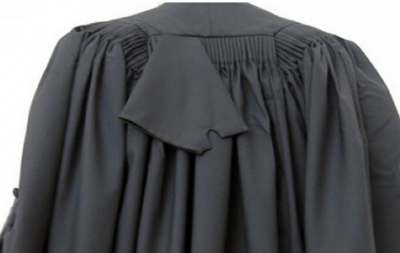
The first is that it was once a money sack for fees. A barrister, being an aristocrat, was too rich to ask for money. He could not be offended. But if some emolument could be slipped into the chute, it would find its way down through the ‘liripipe’. The chute was divided into two segments. One for gold coins, and the other for silver. The clients placed ex-gratia payment into counsel’s money chute, literally behind their back. This way a barrister’s dignity would be preserved, it is said. I suspect it also meant he could not see what was being paid! All he could feel was the heavy jingle of coins, which would be rather persuasive.
The second theory is that the chute is a derivative of the mourning hood introduced following the death of Charles II. That formed part of the traditional mourning dress of the time. The liripipe was originally held in the left hand. The liripipe has survived on the robe to this day, and is now represented by the strip of cloth that hangs down the front of the modern gown.
[6]. Wig
The origin of the wig is lost in the mists of time. It would seem that when Charles II returned to England from France from the court of Louis XIV, he brought with him the trend of the ‘periwig’. Fashion-conscious members of the English society adopted this trend, Barristers fell into this fashion in or about 1663.
At the Mokhtar Hashim trial in 1978, the trial judge was Hashim Yeop Abdullah Sani J.
He created a stir at that trial. He cast aside his wig; and publicly abandoned a long-held judicial tradition.
In July 2007, judges of New South Wales, Australia voted to discontinue the wearing of wigs.
Senior members of the Malaysian Bar say that the practice of wearing wigs in our courts disappeared in the late 1970s.
From all accounts, it appears that wigs were discarded because they tended to itch, were expensive to buy and maintain, and were far too hot for our local weather. What a relief!
After centuries of tradition, the Speaker of the House of Commons in Britain, and more recently the Lord Chancellor himself, have dispensed with wearing a wig in Parliament.
Despite all that, to this day, barristers and judges in Hong Kong still continue to wear wigs as part of their court dress.
[7]. Bar Jacket
Senior advocates sometimes wear a waistcoat combined into a single garment with their jackets. It was called the ‘Bar jacket’ or ‘Court waistcoat’. Lady advocates wear dark suits, but instead of the wing collar, they often wear bands attached to a collarette.
[8]. Bands [Tabs or Jabots]
Until 1640, it was a fashion for lawyers to wear neck ruffs to court. Thereafter they simply swapped neck wraps for ‘falling bands’, so as to conceal the collar of the shirt.
Bands [‘tabs’ or ‘jabots’] are attached to the wing collar of an advocate’s linen shirt.
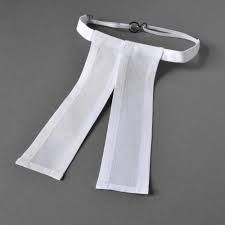 The bands were originally wide, and tied with lace at the front. Even now, you will see some barristers knot the bands by bringing the knot below the chin and under the tabs. The tabs were another indicia of learning, for doctors, clergymen and men of academia also wore them.
The bands were originally wide, and tied with lace at the front. Even now, you will see some barristers knot the bands by bringing the knot below the chin and under the tabs. The tabs were another indicia of learning, for doctors, clergymen and men of academia also wore them.
At an investiture ceremony held at the Middle Temple Hall on 2 May 1594, the Lord Chief Justice advised new recruits about court dress. In referring to the linen ‘bands’, he said:
‘These two tongues do signifie that as you should have one tongue for the rich for your fee, as a reward for your long studies and labours, so should you also have another tongue as ready, without reward, to defend the poor and oppressed.’
To use the word ‘bibs’ for ‘bands’ for the bands is not only a misnomer but also infantile.
[9]. Wing collars
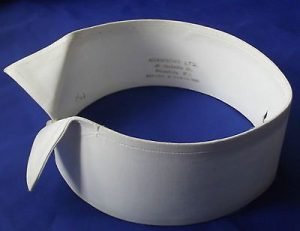
The bands are tied over wing collars.
It is a normal collar with its tips, but with 90% of its circumferential second layer removed.
What is left is a stiff, two inch thick collar.
[10]. Equality
An advocate’s ensemble is a creature of custom and fashion.
In Malaysia, all advocates dress in robes without embellishments. The black colour of the robe and the lack of any distinguishing mark on it demonstrates equality of counsel.
Once an advocate puts on his or her gown, he or she is of the same rank as any other advocate.
It is an ‘equaliser’.
“A black robe grants each Malaysian advocate professional equality. That the one is a senior and the other junior is irrelevant: the former gets no privileges, and the latter is subject to no prejudice. The court is only interested in the truth, and the quality of the arguments.
This is one of the most wonderful qualities of the Malaysian Bar.
We have preserved tradition, but practise what we preach: the primacy of constitutional equality.
[11]. Where can the barristers ensemble be worn?
Gowns and bands are worn only inside the court building. There are, of course, very limited exceptions to this rule: if one was taking the lift down to the basement to have a cup of tea, or if one had to walk across a court to photocopy some documents between hearings, not too much would be made. Even then, one is expected to tuck one’s tabs in under one’s jacket and remove one’s robes. Parading oneself in town as would Batman in the dead of night with the robe flying in the wind, is frowned upon. It is not a done thing.
It is not ‘proper’.
[12]. Ungentlemanly to use Royal Titles
It has thus been a long-standing English tradition, as it is also in Malaysia, that royal titles are never used by counsel when introducing themselves or their opponents – whether within the court or without. A recent circular by the Chief Justice of Malaysia, some years ago, calls this to mind. Again, no lawyer will say, of another lawyer, ‘This is my colleague, Datuk So and So.’ It is never done. No one will insist on being referred to with their royal title. You know why? It detracts from the Equality Principle that lawyers have fought so hard to establish.
[13]. Courtroom Etiquette
The tradition of bowing before a judge is one that has survived many centuries.
One is said to bow not to the judge, but to the ‘presence’ of the King, whom the judge represents.
The tradition of ‘dressing the judge’ [not ‘addressing’ the judge] requires that the barrister should never leave a courtroom if it means that the judge would be left on his own.
Another tradition is that there must be, at any one time, only one person on his [or her] feet addressing the judge.
If there is a real necessity to address the judge while one’s opponent is on his feet, the proper thing to do would be to rise and to ask permission whether you could ‘interpose’.
[14]. The use of certain expressions
Barristers refer to each other as ‘my learned friend’.
To call an opponent ‘my opponent’ or ‘my friend’ is to wound him mortally.
[15]. Traditions and Courtesy
Some traditions are really rules of courtesy. One of these is the practice of ‘standing down’ cases. If your opponent is not in court at the appointed time, and the case is called up for hearing, it is proper to request the judge to ‘stand the case down’ so that you could call to him.
If your opponent is uncouth, or improper, remain silent. When it is your turn, present your case courteously and clearly.
Your tone is everything. You are there to persuade the judge; not berate your opponent.
Judges do not like drama or hysteria.
They prefer the quiet, clear, unassuming voice of reason.
[16]. Have you heard of the ‘Disappearing Counsel’?
There is another tradition at the Bar.
Suppose you are addressing the court.
Apart from the occasional rustle of papers and the hum of the air conditioning, the court is quiet.
All five judges of the Federal Court are listening attentively.
You are telling your client’s side of the story.
If your words are compelling, time does not matter.
There is an occasional query; the others are eager for the story to continue.
The court is interested in the story.
Not you.
Not your Brioni suit.
Not your false western accent which neither fits below south of the Watford Gap, nor above the lilt of Yorkshire.
It is your client’s story.
It is so compelling the judges begin to see pictures of the various points in the story. It is like watching a video.
Tell it.
You disappear.
Only your story is alive and organic. It is a living creature. It enacts itself before the eye of the court’s mind.
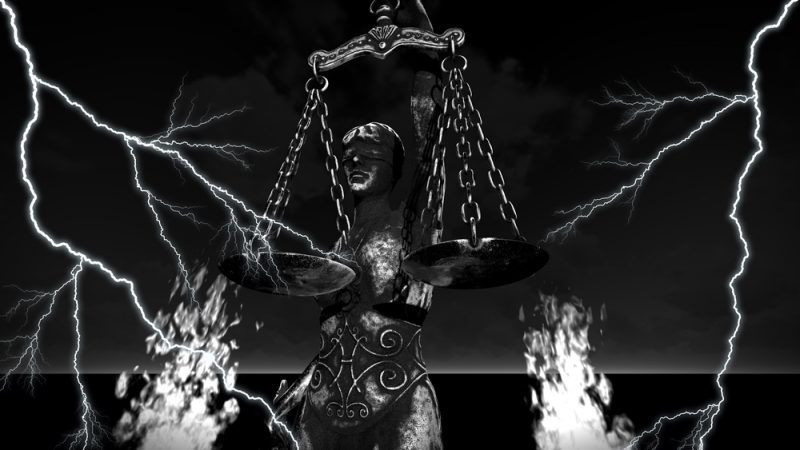
Momentum.
Characterisation.
The sudden twist.
And then the shining question.
Not a confused conclusion that pulls at the nose of the court, but a question that compels the judges to answer in your favour.
Have you ever told stories to you children? Or grandchildren? Try it.
Not all the rhetoric or legal training in the world will prepare you for the innocent, probing questions with which children assail a doubt. If you can answer them, you can answer any supreme court. In any country.
That dear friend, is the disappearing act. It is the tradition of telling a truthful story.
And that is a tradition of the Bar!
[17]. ‘Call to the Bar’
When a trainee was ready to be accepted a barrister, he or she was called by name, and given privilege to enter, from the Gallery, into the Well of the Court. He was called into the Bar. Thus arose the expression ‘called to the Bar’. The occasion itself was called ‘The Call’.
Thus, pupils in Malaysia become members of the Bar by being ‘called to the Bar’.
After his or her training, a pupil will petition the court to become a legal practitioner. On the day of his or her Call, the pupil rises before the judge.
A senior practitioner, a colleague of the pupil-master [called ‘the Mover’] then addresses the judge. He is referred to as the ‘Mover’ because he ‘moves the court’, i.e., he applies to the court to accept the pupil as an advocate and solicitor.
The highlight at the Call is the way the Mover introduces the pupil.
Some counsel quote poetry or scripture, others speak of matters that are important to the general practice at the Bar.
After the Mover’s speech, the judge will make an order ‘admitting and enrolling’ the pupil as an advocate and solicitor.
That right there is a very Malaysian tradition.
And it is quite old.
[17]. Why do we need these traditions at the Bar?
Every profession has its own traditions.
The Bar has its own.
Why bother with stuffy old rules?
Well, traditions define who we are. They identify an advocate’s creed, and what he or she stands for. And they are hallowed by time.
By observing traditions, we pay homage to those who have gone before us – for they it is who have made our path easier to tread.
And in so doing, we leave behind a legacy for those who would come after us.
In that way, we ensure that they walk the professional path with honour, dignity and valour, seeking to assist all, but injuring none.
[I wrote this article in the first quarter of 2014. The Malaysian Bar’s magazine, ‘Praxis’, published it. I reproduce it here.]

